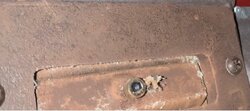New vc encore and new to wood burning
- Thread starter Crash525
- Start date
-
Active since 1995, Hearth.com is THE place on the internet for free information and advice about wood stoves, pellet stoves and other energy saving equipment.
We strive to provide opinions, articles, discussions and history related to Hearth Products and in a more general sense, energy issues.
We promote the EFFICIENT, RESPONSIBLE, CLEAN and SAFE use of all fuels, whether renewable or fossil.
You are using an out of date browser. It may not display this or other websites correctly.
You should upgrade or use an alternative browser.
You should upgrade or use an alternative browser.
gthomas785
Minister of Fire
Actually, I think you will find the opposite. If you keep adding wood 1 piece at a time it will be hard to control the temperature. What I usually do is get the fire going with kindling and then add enough wood to last for 6-8 hours or so. That's usually a full load unless it's warm out. Wait for that to catch and then close the bypass, gradually dial the air back. There will be an initial burst of heat as it gets going but then you can let it cruise at the low temperature for hours. The way you are running it, you never get past the initial heat burst before you have to reload again. It sound like you are trying to burn it more like a fireplace which isn't going to give you satisfactory results.with the way the stove has been burning more than 2 would seem like it was be a glowing red stove.
I had contacted the place I bought it from and they said they will be contacting vermont castings for me about it. They said once it gets up to temp I should be able to turn it down.
No. I was unable to get any by the time I moved in.Do you have seasoned firewood?
What's the difference in having 2 logs in it compared to a full box? The thermostat should choke it out regardless. That's how that works once it gets to a certain temp then it should shut the air supply down to lower the temp. The stove won't lower is the problem.Actually, I think you will find the opposite. If you keep adding wood 1 piece at a time it will be hard to control the temperature. What I usually do is get the fire going with kindling and then add enough wood to last for 6-8 hours or so. That's usually a full load unless it's warm out. Wait for that to catch and then close the bypass, gradually dial the air back. There will be an initial burst of heat as it gets going but then you can let it cruise at the low temperature for hours. The way you are running it, you never get past the initial heat burst before you have to reload again. It sound like you are trying to burn it more like a fireplace which isn't going to give you satisfactory results.
jetsam
Minister of Fire
OP has said twice that he's burning 10% MC softwood. Case closed. 
To the OP, when you get your wood stash seasoned and ready to burn, you will be aiming for 20% MC or lower. 10% and down means it was stored on a windy hill in a desert, not under a tarp in Michigan.
Wood with very low MC will burn like crazy, and the stove will probably not operate like you expect. Load it full of little chunks of 10% pine, and it is easy to overfire most stoves.
It sounds like your tiny load size is probably a good precaution if that's the only fuel you have.
I'd be comfortable burning full loads of that stuff in my stove, but I am very familiar with the stove and know its limits. If you gave me a new stove of exactly the same model, I wouldn't stuff it full of pallet wood until I was comfortable that it was operating as expected and had no air leaks.

To the OP, when you get your wood stash seasoned and ready to burn, you will be aiming for 20% MC or lower. 10% and down means it was stored on a windy hill in a desert, not under a tarp in Michigan.
Wood with very low MC will burn like crazy, and the stove will probably not operate like you expect. Load it full of little chunks of 10% pine, and it is easy to overfire most stoves.
It sounds like your tiny load size is probably a good precaution if that's the only fuel you have.
I'd be comfortable burning full loads of that stuff in my stove, but I am very familiar with the stove and know its limits. If you gave me a new stove of exactly the same model, I wouldn't stuff it full of pallet wood until I was comfortable that it was operating as expected and had no air leaks.
gthomas785
Minister of Fire
The difference is time. How long are you waiting for a response after turning down the air? I read back through your posts and I can see that it maintains 600deg until it starts to go out, but I don't get a sense of how long that is with only 1-2 pieces. An hour maybe?What's the difference in having 2 logs in it compared to a full box? The thermostat should choke it out regardless. That's how that works once it gets to a certain temp then it should shut the air supply down to lower the temp. The stove won't lower is the problem.
It's pretty normal to have high heat output for an hour or so. Small, dry wood will exacerbate the issue, but the stove should still be controllable. I have loaded my encore with well-dried 2x4 cutoffs before, and it goes a little crazy but I can still throttle it back eventually. The key for me is time between reloads. It takes a couple of hours for the temperature to settle, and if your fire is out / needs reloading before then, it's just going to get hotter when you add more fuel.
You won't know if the stove is behaving right unless you have a fire that can sustain for several hours without adding any wood.
With that said. There's a slight chance that the air control cable could be hung up on the casting inside the air channel and not closing all the way. You can check the operation of the primary air damper by lying on the floor and looking up towards the back of the stove. Have a helper turn the air lever for you. There's a small flapper covered by a protective grille with slots in it. With the stove cold and the air all the way down, the air flap should come close to closing but not all the way (bimetallic coil closes it fully when the stove warms up). When you open the air control, you should see substantial movement of the flap. Check again with the stove hot, you should see and hear it "clack" shut when you move the air lever back.
Last edited:
OP has said twice that he's burning 10% MC softwood. Case closed.
To the OP, when you get your wood stash seasoned and ready to burn, you will be aiming for 20% MC or lower. 10% and down means it was stored on a windy hill in a desert, not under a tarp in Michigan.
Wood with very low MC will burn like crazy, and the stove will probably not operate like you expect. Load it full of little chunks of 10% pine, and it is easy to overfire most stoves.
It sounds like your tiny load size is probably a good precaution if that's the only fuel you have.
I'd be comfortable burning full loads of that stuff in my stove, but I am very familiar with the stove and know its limits. If you gave me a new stove of exactly the same model, I wouldn't stuff it full of pallet wood until I was comfortable that it was operating as expected and had no air leaks.
I'm sure my stove is not operating correctly. After everyone in here is telling me thing I take it into account. If the wood is so dry and burns quick why did I end up with this left with the thermostat open and damper open. The wood is not an issue to burn. 1.5 pieces of wood should not be over firing my stove especially with the damper closed and thermostat closed.
The wood actually takes about 1.5 to 2 hours to burn. Which is what I expect. The stove stays 600 degrees the whole time. Cast iron retains heat but it does not mean it stays hot like 600 for hours after the fire dies down. It will fluctuate temp relatively quick such as 20 minutes to drop or rise.
And the stove has never been "stuffed" with pallet wood. Hence why I burn a piece or two at a time.
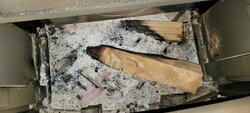
The difference is time. How long are you waiting for a response after turning down the air? I read back through your posts and I can see that it maintains 600deg until it starts to go out, but I don't get a sense of how long that is with only 1-2 pieces. An hour maybe?
It's pretty normal to have high heat output for an hour or so. Small, dry wood will exacerbate the issue, but the stove should still be controllable. I have loaded my encore with well-dried 2x4 cutoffs before, and it goes a little crazy but I can still throttle it back eventually. The key for me is time between reloads. It takes a couple of hours for the temperature to settle, and if your fire is out / needs reloading before then, it's just going to get hotter when you add more fuel.
You won't know if the stove is behaving right unless you have a fire that can sustain for several hours without adding any wood.
With that said. There's a slight chance that the air control cable could be hung up on the casting inside the air channel and not closing all the way. You can check the operation of the primary air damper by lying on the floor and looking up towards the back of the stove. Have a helper turn the air lever for you. There's a small flapper covered by a protective grille with slots in it. With the stove cold and the air all the way down, the air flap should come close to closing but not all the way (bimetallic coil closes it fully when the stove warms up). When you open the air control, you should see substantial movement of the flap. Check again with the stove hot, you should see and hear it "clack" shut when you move the air lever back.
Thanks for the help and info.
I try to close the damper when it gets to 600. I've been really on top of it because it's new to me and I don't want to have an issue of over firing the stove. Once the stove gets hot it takes maybe 40 - 60 minutes to get up to temp then I close the damper and thermostat. I never timed it but it usually takes kindling, adding larger pieces, then larger, then a whole piece. The 1 to 2 pieces usually take about 2 hours to burn but again it won't come down from 600. Normally I can get it to burn for about 3 to 4 hours before having to reload it again. If I don't stay on top of keeping it going when I open the damper and thermostat to reload it, it will go out. I assume the coal bed has not been established but given the temps won't come down I don't want to over load the stove.
The thermostar hardly moves when its not being used. Close and open are the same position. First pic is thermostat closed, second is it opened.
I did the dollar bill test on the front doors and they seem tight, the ash pan I can't get to but it does secure tightly and doesn't move, the griddle appeared a touch loose on the sides but it still had some grip to it.
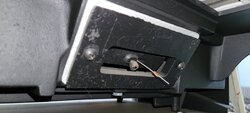
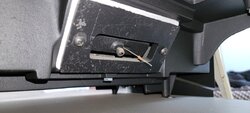
Are the air control flap pictures with a cold stove or a hot stove? Is there a catalyst thermometer on the stove? What thermometer is being used to measure the stovetop temperature and where is it positioned?
gthomas785
Minister of Fire
Were those pics taken with the stove hot or cold? If hot, then there's definitely something wrong with your air control. If cold it's harder to tell but I still think it should move more than that.Thanks for the help and info.
I try to close the damper when it gets to 600. I've been really on top of it because it's new to me and I don't want to have an issue of over firing the stove. Once the stove gets hot it takes maybe 40 - 60 minutes to get up to temp then I close the damper and thermostat. I never timed it but it usually takes kindling, adding larger pieces, then larger, then a whole piece. The 1 to 2 pieces usually take about 2 hours to burn but again it won't come down from 600. Normally I can get it to burn for about 3 to 4 hours before having to reload it again. If I don't stay on top of keeping it going when I open the damper and thermostat to reload it, it will go out. I assume the coal bed has not been established but given the temps won't come down I don't want to over load the stove.
The thermostar hardly moves when its not being used. Close and open are the same position. First pic is thermostat closed, second is it opened.
I did the dollar bill test on the front doors and they seem tight, the ash pan I can't get to but it does secure tightly and doesn't move, the griddle appeared a touch loose on the sides but it still had some grip to it.View attachment 278182View attachment 278183
My first step would be to check if the cable is too tight. Loosen that allen screw and adjust the cable so the flap is barely open when the air control is all the way back. Then try adjusting the lever again. If it still barely moves, the problem is probably at the other end of the cable.
Is the stove under warranty? If it is, I'd call the dealer to look at it.
Otherwise, accessing the control mechanism requires some disassembly from the inside, and it's messy. I'd recommend removing all the ash and vacuuming around the right-side air channel before you start. Then you need to remove the right firebrick and the right-side air channel by undoing the bolts. Careful not to mess up the gasket. I cant remember clearly anymore but you may also have to remove the main airwash manifold from the front in order to get the air channel off. The bimetallic coil and the control cable are inside the air intake channel. Check those for resistance and see if you can figure out where it's hanging up.
When you reassemble, set the air control fully closed so there is some slack in the line. It's really easy to get that cable pinched in the gasket when you bolt the casting back together, so watch out for that. Who knows, maybe that's what happened at the factory and you just need to free it up, idk. You have to pull *out* on the air control lever to engage the friction spring while you fit the air channel back on.
I did mess with mine when I first got the stove. In my case I was getting the opposite of your problem (not enough air) and it turned out to be unrelated - a chimney issue. But nevertheless, I am familiar with this air mechanism and it's a little annoying to work with.
Cold stove. The flap does not move at all when the thermostat is moved. No cat thermometer nor flue thermometer. The griddle blued up pretty good. it's to warm to burn now .Are the air control flap pictures with a cold stove or a hot stove? Is there a catalyst thermometer on the stove? What thermometer is being used to measure the stovetop temperature and where is it positioned?
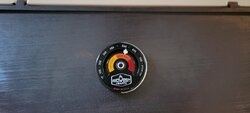
The thermostat operation should be checked with a hot stove. If the flap is not closing with a change of the control then it is possible there is a fault in the thermostat. A catalytic thermometer is a good option to consider.
The thermostat operation should be checked with a hot stove. If the flap is not closing with a change of the control then it is possible there is a fault in the thermostat. A catalytic thermometer is a good option to consider.
I would like to get a cat thermostat sooner or later. Thanks for all the help.
Sooner would be better. Griddle temps really are not nearly as important to monitor as cat and exhaust temps. And stove top temps are the slowest to respond. My guess is you are sitting the air down way to late because especially with really dry wood the stovetop thermometer is taking to long to get to temp. Meaning the fire is already well past where it should be shut backI would like to get a cat thermostat sooner or later. Thanks for all the help.
Sooner would be better. Griddle temps really are not nearly as important to monitor as cat and exhaust temps. And stove top temps are the slowest to respond. My guess is you are sitting the air down way to late because especially with really dry wood the stovetop thermometer is taking to long to get to temp. Meaning the fire is already well past where it should be shut back
It's strange that the manufacturer recommends it. You would think thermometers are cheap. To actually include one with it in key areas.
Edit. About being late to the party on adjusting the temp. Don't you need the stove to heat up to temp as in the whole stove not just inside the fire box?
That manufacturer does lots of things that are strange.It's strange that the manufacturer recommends it. You would think thermometers are cheap. To actually include one with it in key areas.
Diabel
Minister of Fire
OP should focus his attention on how to operate this beautiful yet very finicky stove. As said before go through the “VC thread” lots of great info there. Once you are tired of reading go out and work on your fire wood stacks. Start collecting wood now and in two years your stove will operate as it should.
And soon after that it will need the combustion chamber replaced lol. Sorry I had toOP should focus his attention on how to operate this beautiful yet very finicky stove. As said before go through the “VC thread” lots of great info there. Once you are tired of reading go out and work on your fire wood stacks. Start collecting wood now and in two years your stove will operate as it should.
First pic thermostat is closed, second it’s open. This is on a cold 2550, I know the second pic is a bad shot but that’s what I got reaching behind a dark stove.
Attachments
gthomas785
Minister of Fire
My encore came with a cat thermometer.It's strange that the manufacturer recommends it. You would think thermometers are cheap. To actually include one with it in key areas.
Edit. About being late to the party on adjusting the temp. Don't you need the stove to heat up to temp as in the whole stove not just inside the fire box?
And no, you should adjust the air based on the fire's behavior not the exterior temperature of the stove. The directions talk about stove temp because sometimes that's the only indication you have. But by no means should you wait until it's 600. The temp will continue to climb initially as you shut the air back, I think you've figured that part out
Last edited:
Diabel
Minister of Fire
Sad but you are on the button for 99% of situations.And soon after that it will need the combustion chamber replaced lol. Sorry I had to
I will admit the new ones do seem to be more durable. But still overly complicated and finikySad but you are on the button for 99% of situations.
Hmm interesting. I assume they pretty much work the same. When I go to open my thermostat, about a 5th of the way there I feel and hear a small pop. It's pretty noisy also. Does your thermostat handle operate like that?First pic thermostat is closed, second it’s open. This is on a cold 2550, I know the second pic is a bad shot but that’s what I got reaching behind a dark stove.
Diabel
Minister of Fire
Thermostat is the bi-metalic spring and flap with a probe attached to it. The handle you refer to is the primary air lever/ regulator. In my books. The terminology is a bit confusing when you are new to this. We have all been there.Hmm interesting. I assume they pretty much work the same. When I go to open my thermostat, about a 5th of the way there I feel and hear a small pop. It's pretty noisy also. Does your thermostat handle operate like that?
Similar threads
- Replies
- 5
- Views
- 702
- Replies
- 8
- Views
- 1K
- Replies
- 33
- Views
- 3K


